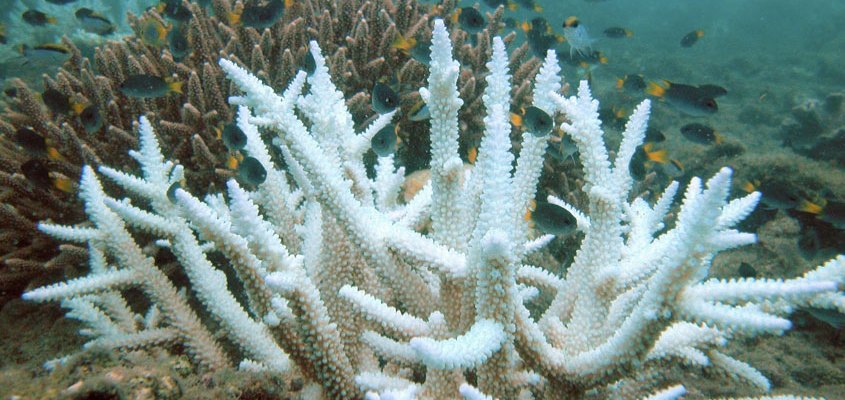|
By Elaine Zhu
One of my favorite Disney movies as a child was Finding Nemo--I loved Dory’s jokes and Marlin’s quest to find Nemo. But what made the movie so memorable were all the beautiful colors and structures of the coral reef where the main characters lived. Imagine my shock when I found out that the Great Barrier Reef — the world’s largest coral reef system and the home of Nemo, Marlin, and all the other marine animals in Finding Nemo— was pronounced “dying” and given an obituaryby Outside Magazine. In 2017, Naturealso published an article demonstrating that large stretches of the Great Barrier Reef’s northern region were declining. Coral reefs are not just beautiful spectacles for humans to enjoy, but they are also an essential part of our oceans, ecosystems, and economies. For example, they are important spawning and feeding grounds for a plethora of marine species and support over 4,000 fish species. They also provide buffers from strong currents or waves and natural protection for vulnerable coastlines. According to the NOAANational Marine Fisheries Service, coral reefs provide over $100 million in commercial value for United States fisheries. In total, the Hopkins Marine Station of Stanford Universityestimates that the coral reefs bring in around $30 billion in economic benefit from tourism, fishery, and food industries. In order to understand why coral reefs are dying, we need to examine the internal structures of coral. The coral species are divided into hard and soft coral. Hard coral builds the foundation of reefs, using the calcium carbonate found in the ocean water to create a strong exoskeleton. On the other hand, soft coral does not have a skeleton and looks similar to trees and other plants, bending to the currents in the ocean. Soft coral also provides a habitat for fish, snails, and other sea organisms as well as protects the shore from wave activity. In reality, while we often use the umbrella term “coral” to describe the reefs and related structures, the coral species is actually made up of individual organisms called “coral polyps,” which are tiny invertebrates related to anemones and jellyfish. These polyps attach themselves to hard surfaces on the seafloor and reproduce to form thousands of clones, eventually becoming a coral colony. As these colonies grow, they connect to other coral colonies to form the large expanses of coral reefs we see today. While coral reefs on the whole are declining, coral itself does not immediately die off and wither away. It first goes through a process called coral bleaching. Coral gains nutrients from microscopic algae cells, called zooxanthellae, that live inside the coral polyps. Zooxanthellae use photosynthesis to convert sunlight into usable energy, which directly benefits the coral housing of these cells. When the zooxanthellae are exposed to different stressors, such as extended periods of high temperatures, they release oxygen-free radicals, which can cause cell membranes to decay and which are dangerous to the coral’s health. This causes the coral polyps to eject the algae cells, which causes the remaining coral to turn almost completely white, since the algae provides the pigment to the coral. Because the algae cells give the coral its essential nutrients, this ejection also leaves the coral vulnerable, and, oftentimes, the coral ends up dying. Ultimately, though, coral bleaching does not necessarily mean the coral is dead—the coral can often actually recover from these bleaching events. Recently, scientists found that the time between these bleaching events is shortening, leaving an inadequate amount of time for the coral to recover. So what is causing the decline of coral reefs? In recent years, global warming has been creating increasing amounts of stressors for the coral. Specifically, because of increased amounts of greenhouse gases due to human activity, ocean temperatures and sea levels are rising, storm activity and hurricanes are changing, and the ocean is acidifying—all of which negatively affect coral reef ecosystems. These stressors not only cause increased amounts of coral bleaching but can also lead to the smothering or destruction of coral reef systems and decrease coral growth. As a result, coral reefs have been struggling to keep up. In fact, a recent 2019Naturearticlefound that “the amount of larval recruitment declined in 2018 by 89% compared to historical levels” due to “unprecedented back-to-back mass bleaching events caused by global warming.” Coral reefs have existed on Earth much longer than humans have inhabited this planet, yet they are facing mass bleaching and death due to human activities. Changing our actions could stop further harm to the coral reefs. The Australian government has already set forth a “Reef 2050 Long-Term Sustainability Plan,” which provides a plan of action for reducing human actions that damage coral. Some of its proposed actions include reducing the pollution of ports and agriculture into the Great Barrier Reef, and placing protection on sea turtles and animals through new policies against poaching. While this sustainability plan is a step in the right direction, everyone can protect coral reefs in their own way. For example, by conserving water, choosing sustainable seafood, and reducing our individual carbon footprint, we can all make a difference in protecting coral reefs. If we reduce greenhouse emissions and slow down global warming, we may be able to halt the quickening process of coral bleaching in its tracks and save the home of Marlin, Dory, and Nemo.
0 Comments
Leave a Reply. |
Categories
All
Archives
April 2024
|

